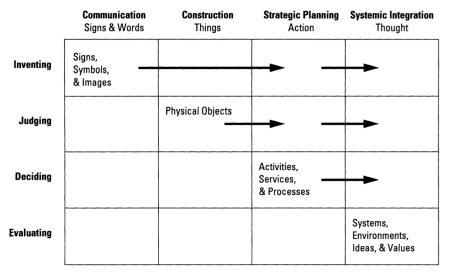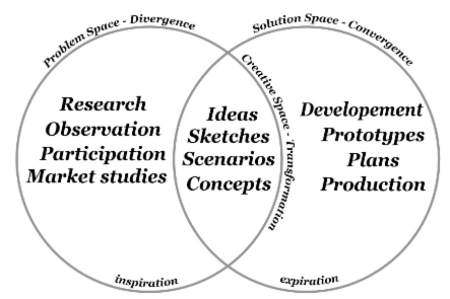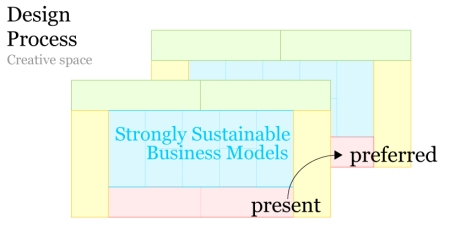Design is the first lens through which we will study the object of research, which is strongly sustainable business models. The first element that needs to be established is how design is a process. Then we move on to the multiple orders the design process. We choose to focus on three dimensions that can be found in most descriptions of the design process. It is an iterative process, a divergent and convergent process and an integrative process.
Defining design as a process.
Industrial design flourished in the 1950s during the post war boom. The industrial know-how was now mature enough to favour designers and their creativity. In the very beginning, the design process was understood as mostly an effort of styling (Read & Read 1966). Then came the application of the “form follows function” mantra, where the design process was striving for a rational approach to create products. This became the starting point of functionalism. The goal of design was to reify the function which would then suggest a choice in materials which in turn would determine a proper shape (Heskett & Giorgetta 1980). Such an undertaking had reductionist objectives to rationalize a design process that had to deal with emotion, beauty and human values (Jones 1992).
Defining design has often been a difficult task because it is comprised of many intangible elements such as intuition, imagination and creativity. Still today Herbert Simon is recognized as having provided a starting point when defining design. He stated that design was “moving from existing situations to preferred situations” (Simon 1969). This way of reasoning the designer’s approach can be linked to Simon’s “bounded rationality” applied in organizations. Moreover, the process of design is a difficult undertaking because it deals with more elusive elements such as ambiguity and uncertainty. Although these human intangibles can be seen as barriers to scientific epistemologies, including heuristics enables design to confront and ultimately shape the reality of everyday life. Then on, industrial design was to be understood as a process that leads to the creation of new products.
Today, some designers are moving past the industrial aspect of product design for broader outcomes. By expanding on the different actions of the design process as well as on the different outcomes, Buchanan (1998) describes a design matrix. It has four areas called “orders”. First is communication relates to signs and words, second construction relates to things, third strategic planning relates to action and fourth systemic integration relates to thoughts. Buchanan then intersects these orders with designer abilities, which are inventing, judging, deciding and evaluating. He proposes his matrix as an interpretative lens for investigating the “shifting debate about design in the contemporary world”.
Buchanan’s 4 orders of design
Figure 1. Buchanan (1998)
The matrix can also serve as a historical account of the disciplines of design formed through encounters with new problems. Buchanan’s matrix is further developed by Golsby-Smith (1996) whom illustrates that the orders do not replace each other but rather build on each other. This embeddedness is widens of the outreach of design into other fields such as management. In other words, design has evolved from creating symbolic forms, to harmonious functions, then meaningful interactions and now purposeful organizations.
Henceforth, design is a process that leads to multiple outcomes. Before speaking of how a design process can apply to business model, we will review four characteristics of the design process in greater detail.
Design is a divergent and convergent process
Research on the design process has been described most proficiently in the 1980’s under the name of design methodology. Many different researchers (Jones 1969, Cross 1981, Quarante 1984) proposed their interpretation of the process. In the end, the notion of convergence and divergence is present in all interpretations. Design methods are essentially a form of analysis-synthesis-realization. We chose to follow Jones’ terminology of creative space where divergence in the problem space meets convergence in the solution space. Formulating the problem leads to designing a preferred situations. In other words, a good understanding of the problem space creates opportunities for generating new concepts which leads into the solution space.
Three spaces of the design process
Figure 2. Adapted from Jones (1969).
Design is an iterative process
The design process is described by Findeli as an ongoing loop linking thinking and acting as well as inspiration and expiration. This further promotes the idea that the design process is not a systematic step-by-step sequence of pre-determined activities. In contrast, creativity works best when progressing in multiple back and forths between the problem and solutions spaces. Any design method must permit multiple kinds of logical, ethical or creative thoughts to coexist within the iterative progress of the project (Findeli 2001).
Design is an integrative process
By rejecting a closed choice between two options, design creates new solutions starting from consensual forms of reasoning. This was coined as integrative thinking by Martin (2009). Creating a third way requires what the philosopher Pierce (1957) called an abductive approach. An example of an integrative process comes from the early designers’ capacity to develop goods that accomplished a function and that were fit for an industrial production. But now that a certain mastery has been attained in the production and marketing of products, the focus has shifted to the individual user.
This term user-centered was first proposed by Norman (2002) when he argued for redefining the goal of product design to first and foremost cater to the needs of the users. In sum, the integrative process that is design looks to create solutions that answer conflicting needs of multiple stakeholders.
In this paper, we choose to study business model innovation through the lens of design theory. Time has already demonstrated how design has influenced product innovation in the latest phase of the industrial revolution. From this point on, we wish to establish a parallel with how design methods can contribute to business model innovation in the subsequent phase.
A design approach to shed light on strongly sustainable business models.
The famous GE manager, Jack Welch, once said: “Change before you have to.” Since the 1980s, forward thinking organizations innovate with a formalized design process called new product development. In following Buchanan’s orders, the next level is to design the service interactions. Service design is an ever more present in research and practice (Stickdorn & Schneider 2010). The creation of new user experiences has influenced industrial designers to start thinking in a broader approach, not just in terms of improving products but in terms of innovating business models. However, the 4th level of strategy and organization has just recently been addressed by a design process.
Called design thinking, this movement was captured by management to solve their seemingly dialectical problems by using creativity and empathy for the customer (Brown 2008). Designer Marty Neumier, puts it this way: “Problems you can’t manage your way out of.” This means combining the analytical approach taught by management schools and the situational understanding taught in social science schools (Bolland & Collopy 2004).
The shortcoming of the expression design thinking is that it doesn’t express the importance of making. This refers to Jones’ creative space that includes activities such as sketching and prototyping. Nonetheless, we can affirm that design thinking is at the origin of the creation of material products, and that same process applies in solving any type of business problem.
Although design thinking is not a theory to approach the entirety of organizations, it is a process that sheds some new light on how organizations engage in dynamic self renewal. This process of “moving to preferred states” is applied in developing a strategy for the organization. That’s when we argue that a process of design should be applied to creating new business models. Therefore undertaking a design process to create business models ensues a divergent-convergent, iterative and integrative approach.
We have mentioned that the design process is focused on answering needs. But whose needs? The organization or the client’s? Our object of study includes the sustainability aspect of business models. Therefore the design process should be able to take into account the needs of the individual user, society at large, the organization, the financial balance, the environment and even future generations. That is a tall order, but it matches the challenges of the 21st century.
Figure 3. Joyce (2013)
So far we have demonstrated how design is a process that can be applied to business models. Designing business models is a natural evolution following Buchanan’s 4th order design. Moving from analysis in the problem space to synthesis in the solution space, all the while in successive iterations, the design process evolves to an integrative understanding of all the actors of the situation. However, the business model built upon many dynamic relationships. A complex systems approach is better suited to study such interactive aspects of a strongly sustainable business model.




Great article. Interesting how the organizations could take advantage of the design process.